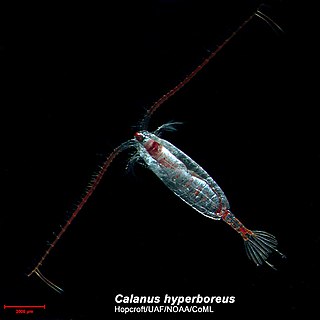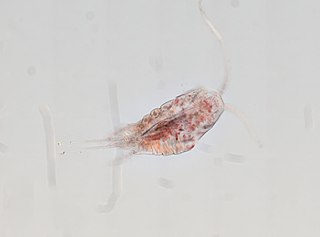Related Research Articles

Calanoida is an order of copepods, a group of arthropods commonly found as zooplankton. The order includes around 46 families with about 1800 species of both marine and freshwater copepods between them. Calanoid copepods are the dominant animals in the plankton in many parts of the world's oceans, making up 55%–95% of plankton samples. They are therefore important in many food webs, taking in energy from phytoplankton and algae and 'repackaging' it for consumption by higher trophic level predators. Many commercial fish are dependent on calanoid copepods for diet in either their larval or adult forms. Baleen whales such as bowhead whales, sei whales, right whales and fin whales rely substantially on calanoid copepods as a food source.
Acartia hudsonica is a species of marine copepod belonging to the family Acartiidae. Acartia hudsonica is a coastal, cold water species that can be found along the northwest Atlantic coast.
Acartia tonsa is a species of marine copepod in the family Acartiidae.

Calanus hyperboreus is a copepod found in the Arctic and northern Atlantic. It occurs from the surface to depths of 5,000 metres (16,000 ft).
Calanus glacialis is an Arctic copepod found in the northwestern Atlantic, adjoining waters, and the northwestern Pacific and its nearby waters. It ranges from sea level to 1,800 metres (5,900 ft) in depth. Females generally range from about 3.6 to 5.5 millimetres in length, and males generally range from about 3.9 to 5.4 millimetres in length.
Calanus helgolandicus is a copepod found in the Atlantic, from the North Sea south to the western coast of Africa. The female has an average size of about 2.9 millimetres (0.11 in) and the male has an average size of about 2.7 millimetres (0.11 in).
Calanus propinquus is a copepod found in Antarctica, and the surrounding waters.

Calanoides acutus is a copepod found in Antarctica and the surrounding waters.
Metridia longa is a copepod found in the Arctic, the north Atlantic, the Pacific, and surrounding waters. The female has an average length of about 4.2 millimetres (0.17 in), and the males have an average length of about 3.5 millimetres (0.14 in).
Neocalanus plumchrus is a large copepod found in the Pacific and Arctic Oceans. It was described in 1921 by Marukawa. N. flemingeri used to be placed in this species, likely as a form, until it was split in 1988 by Charles B. Miller.
Neocalanus cristatus is a species of copepod found primarily in the northern Pacific.
Eucalanus bungii is a copepod found in the north Pacific and surrounding waters.
Pseudocalanus newmani is a copepod found in Arctic and northern Pacific waters. It was described by Frost in 1989. It is found in the Arctic and surrounding waters. There are multiple generations. Unlike some copepods, P. newmani undergoes reverse diel vertical migration, descending during the night, and ascending during the day, although it may undergo normal or no migration at all depending on predation. This copepod is primarily herbivorous.
Calanus sinicus is a copepod found in the northwest Pacific.
Subeucalanus pileatus is a tropical and subtropical copepod.
Rhincalaus nasutus is a copepod in the family Rhincalanidae.

Temora stylifera is a copepod primarily found in the Atlantic and surrounding waters.

Paracalanus parvus is a copepod found throughout the world, except the Arctic.
Pseudocalanus elongatus is a copepod found primarily in the Atlantic Ocean.
Metridia gerlachei is a copepod found primarily in Antarctic and sub-Antarctic waters.
References
- ↑ All seasons are for the Northern Hemisphere
- 1 2 3 Lischka, Silke; Hagen, Wilhelm (2005). "Life histories of the copepods Pseudocalanus minutus, P. acuspes (Calanoida) and Oithona similis (Cyclopoida) in the Arctic Kongsfjorden (Svalbard)". Polar Biology. 28 (12): 910–921. doi:10.1007/s00300-005-0017-1. ISSN 0722-4060.
- 1 2 Razouls C.; de Bovée F.; Kouwenberg J.; Desreumaux N. (2018). "Diversity and Geographic Distribution of Marine Planktonic Copepods". Sorbonne Université, CNRS. Retrieved 20 October 2018.
- ↑ Yamaguchi, Atsushi; Ikeda, Tsutomu; Shiga, Naonobu (1998). "Population structure and life cycle of Pseudocalanus minutus and Pseudocalanus newmani (Copepoda: Calanoida) in Toyama Bay, southern Japan Sea". Plankton Biology and Ecology. 45 (2).
- 1 2 Lischka, Silke; Hagen, Wilhelm (2007). "Seasonal lipid dynamics of the copepods Pseudocalanus minutus (Calanoida) and Oithona similis (Cyclopoida) in the Arctic Kongsfjorden (Svalbard)". Marine Biology. 150 (3): 443–454. doi:10.1007/s00227-006-0359-4. ISSN 0025-3162.